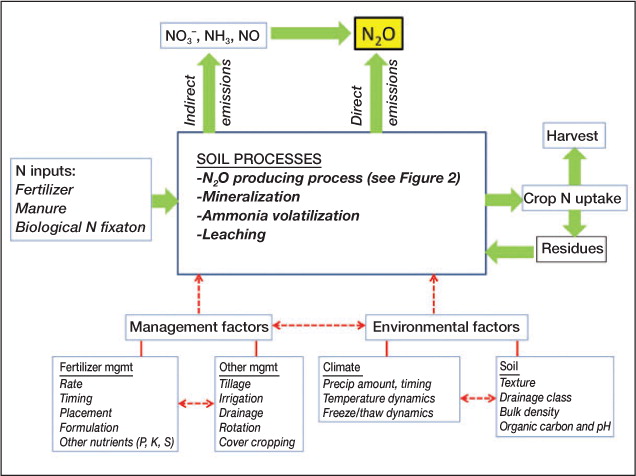Guiding principles to reduce nitrous oxide emissions at field level. At the field scale there are a number of guiding principles that will reduce N2O emissions which can make significant GHG emission reductions.
- The most obvious is matching N applied (whether as fertiliser, farm yard manure or brought in organic material such as sewage sludge) to the crop’s requirements. Measuring soil mineral nitrogen in the spring to give an idea of available soil N alongside the tool with give greater accuracy to the assessment. Applying too much fertiliser is both a waste of money, has the potential to pollute watercourses and increases GHG emissions.
- Timing of fertiliser applications in relation to timing of both crop uptake and also the weather can make a significant difference as N2O emissions will increase substantially in water logged or even warm and wet soils (due to increased activity by denitrifying bacteria). Applying fertilizers that are nitrate based (such as the standard 34% N ammonium nitrate) within 24 hours (before or after) of rain can reduce potential N2O emissions by 20%. Urea applications are more prone to losses of NH4 in windy weather as the moving air increases the volatilisation of NH4 from the soil. However it is more suitable as an early spring fertiliser as it is less susceptible to GHG emissions from high soil moisture levels. Splitting applications so that the quantity of N applied is sufficient for two weeks growth rather than 2 months will clearly reduce both the losses of N from the soil (and crop_ and GHG emissions despite the increased emissions from extra field operations.
- Tailoring fertilizer application to the site specific yield potential of a crop within the field is one of the benefits of Precision Farming. There are a large number of specialist advisors, and farmers, who are developing precision farming and would help you explore the potential for such a system on your farm.
- How the nutrients are applied and any opportunity for incorporation into the soil is likely to make a difference but there is currently little research being done on this aspect. Speedy incorporation of organic materials prior to crop establishment has been demonstrated to reduce GHG emissions and loss of N from NH4 volatilization, particularly from chicken manure.
- Soil moisture, soil temperature, pH, soil organic matter and structure will all have an influence on what happens to the nitrogen in the fertilizer once it is applied to the soil – see diagram below. However attention to how much and when fertilizers are applied are very directly under your control and will have the most impact on GHG emissions and worth focussing on first.


